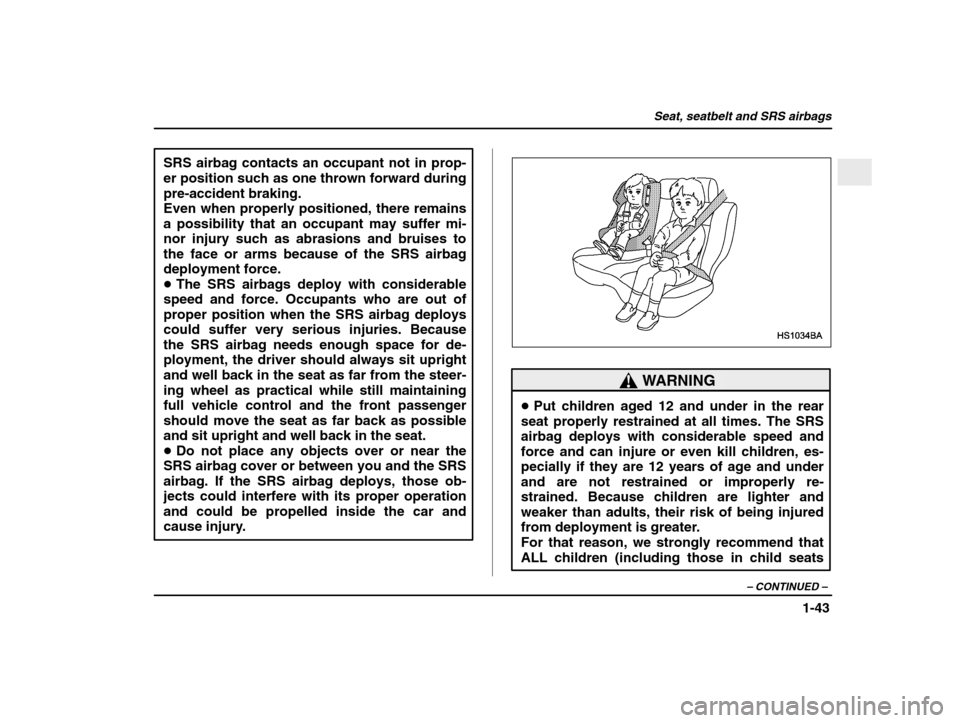Page 67 of 425

Seat, seatbelt and SRS airbags
1-42
*SRS airbag (Supplemental Restraint System airbag)
*SRS: This stands for supplemental restraint system. This name is used because the airbag system sup- plements the vehicle’s seatbelts.
� Vehicle with driver ’s and front pas-
senger’ s SRS airbags and lap/shoul-
der restraints
Your vehicle is equipped with a supplemental
restraint system in addition to a lap/shoulder belt at
each front seating position.
The supplemental restraint system (SRS) consists of two airbags (driver ’s and front passenger ’s frontal
airbags) or four airbags (driver ’s and front passen-
ger’ s frontal airbags and driver ’s and front passen-
ger’ s side airbags).
These SRS airbags are designed only as a sup- plement to the primary protection provided by the seatbelt.WARNING
� To obtain maximum protection in the event
of an accident, the driver and all passengers in the vehicle should always wear seatbeltswhen the vehicle is moving. The SRS airbag is
designed only as a supplement to the primary
protection provided by the seatbelt. It does
not do away with the need to fasten seatbelts.
In combination with the seatbelts, it offers thebest combined protection in case of a seriousaccident. Not wearing a seatbelt increases the chance of severe injury or death in a crash even whenthe car has the SRS airbag. For instructions and precautions concerningthe seatbelt system, see the “Seatbelts” sec-
tions in this chapter. � Do not sit or lean unnecessarily close to the
SRS airbag. Because the SRS airbag deploys with considerable speed – faster than the
blink of an eye – and force to protect in high
speed collisions, the force of an airbag can in-jure an occupant whose body is too close to SRS airbag. It is also important to wear your seatbelt to
help avoid injuries that can result when the
Page 68 of 425

Seat, seatbelt and SRS airbags
1-43
– CONTINUED –
SRS airbag contacts an occupant not in prop- er position such as one thrown forward during
pre-accident braking.Even when properly positioned, there remains
a possibility that an occupant may suffer mi-nor injury such as abrasions and bruises to
the face or arms because of the SRS airbag
deployment force.�The SRS airbags deploy with considerable
speed and force. Occupants who are out ofproper position when the SRS airbag deploys
could suffer very serious injuries. Because the SRS airbag needs enough space for de- ployment, the driver should always sit uprightand well back in the seat as far from the steer-ing wheel as practical while still maintainingfull vehicle control and the front passengershould move the seat as far back as possible and sit upright and well back in the seat. � Do not place any objects over or near the
SRS airbag cover or between you and the SRSairbag. If the SRS airbag deploys, those ob-jects could interfere with its proper operationand could be propelled inside the car and
cause injury.
WARNING
� Put children aged 12 and under in the rear
seat properly restrained at all times. The SRS airbag deploys with considerable speed andforce and can injure or even kill children, es-
pecially if they are 12 years of age and under and are not restrained or improperly re- strained. Because children are lighter and
weaker than adults, their risk of being injured
from deployment is greater. For that reason, we strongly recommend thatALL children (including those in child seats
Page 69 of 425

Seat, seatbelt and SRS airbags
1-44
and those that have outgrown child restraint
devices) sit in the REAR seat properly re-strained at all times in a child restraint deviceor in a seatbelt, whichever is appropriate forthe child’s age, height and weight.
Secure ALL types of child restraint devices
(including forward facing child seats) in the
REAR seats at all times.
According to accident statistics, children are
safer when properly restrained in the rearseating positions than in the front seatingpositions. For instructions and precautions concerning the child restraint system, see the “Child re-
straint systems ” section in this chapter.
� NEVER INSTALL A REARWARD FACING
CHILD SEAT IN THE FRONT SEAT. DOING SO
RISKS SERIOUS INJURY OR DEATH TO THE
CHILD BY PLACING THE CHILD ’S HEAD TOO
CLOSE TO THE SRS AIRBAG. � Never allow a child to stand up, or to kneel
on the front passenger ’s seat, or never hold a
child on your lap or in your arms. The SRS air-bag deploys with considerable force and can injure or even kill the child.CAUTION
� When the SRS airbag deploys, some smoke
will be released. This smoke could cause breathing problems for people with a history of asthma or other breathing trouble. If you oryour passengers have breathing problems af-
ter SRS airbag deploys, get fresh air promptly.� A deploying SRS airbag releases hot gas.
Occupants could get burnt if they come into direct contact with the hot gas.
NOTE When you sell your vehicle, we urge you to ex- plain to the buyer that it is equipped with SRS
airbags by alerting him to the applicable sectionin this owner ’s manual.
Page 70 of 425
Seat, seatbelt and SRS airbags
1-45
– CONTINUED –
1) Airbag control module
(including impact sensors)
2) Airbag module (driver ’s side)
3) Airbag module (passenger ’s
side)
4) Front sub sensor (left hand side)
5) Front sub sensor (right hand
side)
6) Side airbag module
(driver’ s side — if equipped)
7) Side airbag module (passenger’ s side — if
equipped)
8) Side airbag sensor (driver ’s
side — if equipped)
9) Side airbag sensor (passenger’ s side — if
equipped)
10) Airbag wiring (yellow)
11) Seatbelt pretensioner (driver ’s
side)
12) Seatbelt pretensioner (passenger’ s side)
Page 71 of 425
Seat, seatbelt and SRS airbags
1-46
�SRS frontal airbag
The driver ’s SRS frontal airbag is stowed in the cen-
ter portion of the steering wheel. The passenger ’s
SRS frontal airbag is stowed near the top of the
dashboard under an “SRS AIRBAG ” mark.
In a moderate to severe frontal collision, the driver ’s
and front passenger ’s SRS frontal airbags deploy
and supplement the seatbelts by reducing the im- pact on the driver ’s and front passenger ’s head and
chest.
WARNING
NEVER INSTALL A REARWARD FACING
CHILD SEAT IN THE FRONT SEAT. DOING SO
RISKS SERIOUS INJURY OR DEATH TO THE
CHILD BY PLACING THE CHILD ’S HEAD TOO
CLOSE TO THE SRS AIRBAG.
Page 72 of 425
Seat, seatbelt and SRS airbags
1-47
– CONTINUED –
WARNING
Never allow a child to stand up, or to kneel on the front passenger ’s seat. The SRS airbag
deploys with considerable force and can in- jure or even kill the child.
WARNING
Never hold a child on your lap or in your arms. The SRS airbag deploys with considerableforce and can injure or even kill the child.
Page 73 of 425
Seat, seatbelt and SRS airbags
1-48
WARNING
The SRS airbag deploys with considerable speed and force. Occupants who are out ofproper position when the SRS airbag deploys
could suffer very serious injuries. Becausethe SRS airbag needs enough space for de- ployment, the driver should always sit upright and well back in the seat as far from the steer-ing wheel as practical while still maintainingfull vehicle control and the front passengershould move the seat as far back as possibleand sit upright and well back in the seat.It is also important to wear your seatbelt to
help avoid injuries that can result when theSRS airbag contacts an occupant not in prop-er position such as one thrown toward thefront of the car during pre-accident braking.
WARNING
Do not put any objects over the steering wheel pad and dashboard. If the SRS frontal
airbag deploys, those objects could interferewith its proper operation and could be pro-
pelled inside the vehicle and cause injury.
Page 74 of 425
Seat, seatbelt and SRS airbags
1-49
– CONTINUED –
WARNING
Do not attach accessories to the windshield, or fit an extra-wide mirror over the rear view
mirror. If the SRS airbag deploys, those ob-jects could become projectiles that could seri-ously injure vehicle occupants.